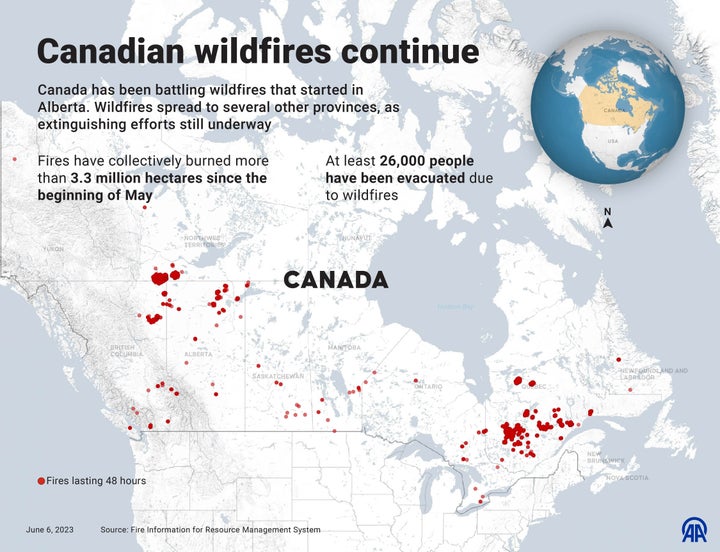Carbon dioxide levels in the atmosphere are now more than 50% higher than the average before the industrial era.
United States scientists documented the highest level of carbon dioxide in the atmosphere in millions of years, at the same time as record wildfires blazed through Canada, lacing the air from the Midwest to the East Coast in a blanket of smoke with enough disease-causing particles to make venturing outside unsafe for people with breathing problems.
Carbon dioxide levels measured at the federal government’s Mauna Loa Atmospheric Baseline Observatory in Hawaii reached concentrations of 424 parts per million in May, the month when the heat-trapping gas typically peaks in the Northern Hemisphere.
That’s more than 50% higher than before the industrial era began roughly 250 years ago and 3 parts per million higher than what federal scientists counted in May 2022. It represents the fourth-largest annual increase since the National Oceanic and Atmospheric Administration started its tally 65 years ago. In a separate analysis, the Scripps Institution of Oceanography at the University of California San Diego announced almost identical findings.
The eruption of Mauna Loa volcano on Nov. 29, 2022, buried over a mile of access road and destroyed transmission lines delivering electricity to the observatory campus for 10 days. But NOAA restored its measuring operation with temporary equipment installed on the deck of the University of Hawaii’s observatory, located near the summit of the Mauna Kea volcano. Scripps began collecting air samples at Mauna Kea six days later, and resumed sampling at Mauna Loa on March 9.
The University of California researchers collected samples from both Mauna Loa and Mauna Kea every day during May and found nearly identical results: Mauna Loa showed 423.78 parts per million carbon dioxide, Mauna Kea indicated 423.83 parts per million.
While NOAA’s satellites monitor wildfire smoke, the carbon concentrations recorded in Hawaii represent centuries of emissions into the atmosphere which have increased dramatically in total annual volume in recent decades. Increasingly catastrophic blazes like those in North America are one of many symptoms of global temperatures rising as increased carbon dioxide traps more of the sun’s heat within the Earth’s atmosphere.
The result announced Monday amounts to what the federal research agency called a “broken record,” an apparent reference to both its unprecedented new height and the routineness with which each passing year brings higher carbon dioxide levels than the previous.
“Every year we see carbon dioxide levels in our atmosphere increase as a direct result of human activity,” NOAA Administrator Rick Spinrad, a veteran oceanographer whose research received awards from presidents from both parties, said in a statement.

“Every year, we see the impacts of climate change in the heat waves, droughts, flooding, wildfires and storms happening all around us. While we will have to adapt to the climate impacts we cannot avoid, we must expend every effort to slash carbon pollution and safeguard this planet and the life that calls it home,” he said.
The sobering report came at the same time as massive plumes of smoke from wildfires in Canada took aim at the eastern half of the United States, including densely populated regions that, unlike the drought-parched western half of North America, have typically been spared the worst effects of large-scale blazes.
Canadian officials have called the start of this year’s wildfire season “unprecedented.” So far, nearly 7 million acres — an area roughly the size of Massachusetts — have gone up in flames.
As of Monday, more than 400 active fires were burning across multiple provinces, and Canadian officials are forecasting a bleak summer.
“Our modeling shows this may be an especially severe wildfire season throughout this summer,” Prime Minister Justin Trudeau told reporters Monday. “This is a scary time for a lot of people.”
Bill Blair, Canada’s minister of emergency preparedness, said Monday that an estimated 26,000 people remained evacuated from their homes. He called the current wildfire activity “some of the most severe ever witnessed in Canada.”
Since mid-May, smoke plumes from fires in western Canada have moved into the U.S. Northeast, bringing hazy skies and air quality warnings. Fiery sunsets and reddish-looking moons have been common across Maine and other states this spring.
HuffPost visited a salt marsh near the eastern tip of New York’s Long Island on Saturday and spoke to a fisherman visiting from Colorado, who detected the distinct smell of wildfire smoke hanging in the air. By Tuesday, National Weather Service officials in New York City issued a “red flag” alert for unhealthy air as smoke cast a visible gray pale from the Verrazzano Bridge to the Manhattan skyline.
Breathing in the particulate matter from wildfire smokes and the exhaust from burning fossil fuels is linked to all kinds of ailments, from lung cancer and heart attacks to dementia and erectile dysfunction. Harvard University researchers estimate that air pollution from fossil fuels alone causes 20% of all deaths worldwide. At least 33,000 people globally die each year just from wildfire smoke, particularly in Central and South America, according to a 2021 study published in the journal Lancet.
Credit: Source link